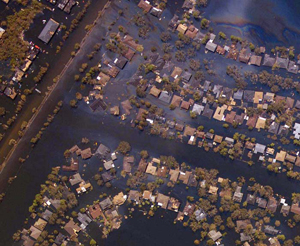Climate Change
Society Impacts & Adaptation
Society Impacts & Adaptation

Climate Impacts on Society
Key Points
- Climate change will affect certain groups more than others, particularly groups located in vulnerable areas and the poor, young, old, or sick.
- Cities are sensitive to many impacts, especially extreme weather impacts.
- Climate change may threaten people's jobs and livelihoods.
Related Links
EPA:
- Climate Change and Society (PDF) (2 pp, 588KB)
- Environmental Justice
- American Indian Environmental Office
Other:
-
USGCRP Synthesis Assessment Product 4.6: Analyses of the effects of global change on human health and welfare and human systems

- USGCRP Global Climate Change Impacts in the United States: Society
-
IPCC Fourth Assessment Report, Working Group II

-
NRC America's Climate Choices: Adapting to the Impacts of Climate Change

-
Northern Arizona University: Tribes & Climate Change

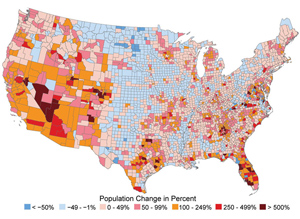 View enlarged image
View enlarged image
The percentage change in population across the United States from 1970 to 2008. Source: USGCRP (2009)
As a society, we have structured our day-to-day lives around historical and current climate conditions. We are accustomed to a normal range of conditions and may be sensitive to extremes that fall outside of this range.
Climate change could affect our society through impacts on a number of different social, cultural, and natural resources. For example, climate change could affect human health, infrastructure, and transportation systems, as well as energy, food, and water supplies.
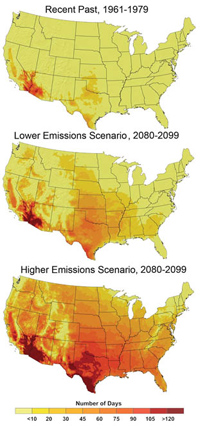 View enlarged image
View enlarged image
Number of days likely to exceed 100°F by the end of this century - in low and high emissions scenarios. Source: USGCRP (2009)
Some groups of people will likely face greater challenges than others. Climate change may especially impact people who live in areas that are vulnerable to coastal storms, drought, and sea level rise or people who are poor. Similarly, some types of professions and industries may face considerable challenges from climate change. Professions that are closely linked to weather and climate, such as outdoor tourism and agriculture, will likely be especially affected.
Impacts on Vulnerability and Equity
Projected climate change will affect certain groups of people more than others, depending on where they live and their ability to cope with different climate hazards. In some cases, the impacts of climate change would worsen existing vulnerabilities.
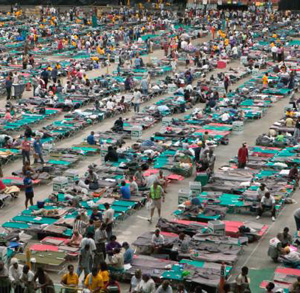
Thousands of New Orleans evacuees lived at the Houston Astrodome for days after Hurricane Katrina in 2005. Source: FEMA (2005)
Geographic Location
Where people live influences their vulnerability to climate change.
- Over the past four decades, population has grown rapidly in coastal areas and in the southern and western regions of the United States. These areas are most sensitive to coastal storms, drought, air pollution, and heat waves. [1]
- Populations in the Mountain West will likely face water shortages and increased wildfires in the future. [1]
- Arctic populations will likely experience problems with melting permafrost and reduced sea ice. [1]
- Along the coasts and across the western United States, both increasing population and changes in climate place growing demands on transportation, water, and energy infrastructure. [1] [2]

Elderly people are particularly prone to heat stress. Source: CDC (2009)
Ability to Cope
Different groups have different abilities to cope with climate change impacts.
- People who live in poverty may have a difficult time coping with changes. These people have limited financial resources to cope with heat, relocate or evacuate or respond to increases in the cost of food. [1] [2]
- Older adults may be among the least able to cope with impacts of climate change. Older residents make up a larger share of the population in warmer areas of the United States. These areas will likely experience higher temperatures, tropical storms, or extended droughts in the future. [1]
- Young children are another sensitive age group, since their immune system and other bodily systems are still developing and they rely on others to care for them in disaster situations. [2] To find out more about climate change and health, please visit the Health Impacts & Adaptation page.
Native Americans
Native Americans are particularly vulnerable to projected changes in climate for a number of reasons. Their communities are closely tied to specific reservation boundaries that restrict their ability to relocate to avoid climate change impacts. Their opportunity to change their livelihoods may be limited, and they may have difficulty coping with impacts, including those on water resources, agriculture and ecosystems. For example, tribes located in the Southwest are projected to experience changes in water quality and water availability on their lands. [1] Furthermore, climate change may significantly affect cultural traditions practiced by tribes. For example, certain Alaskan Natives have cultural ties with animals, such as seals and caribou, which will experience changes to their habitats. [1]
Urban Populations
City residents and urban infrastructure have distinct sensitivities to climate change impacts. [1] For example, heat waves may be amplified in cities because cities absorb more heat during the day than suburban and rural areas.
Cities are more densely populated than suburban or rural areas. In fact, more than 80% of the U.S. population lives in urban areas. As a result, increases in heat waves, drought, or violent storms in cities would affect a larger number of people than in suburban or rural areas. [1]
Higher temperatures and more extreme events will likely affect the cost of energy air and water quality, and human comfort and health in cities.
City dwellers may also be particularly susceptible to vulnerabilities in aging infrastructure. This includes drainage and sewer systems, flood and storm protection assets, transportation systems, and power supply during periods of peak demand, which typically occur during summer heat waves.
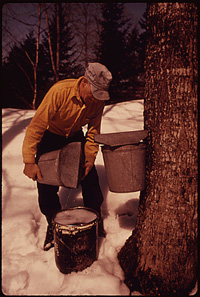
Farmer harvesting maple syrup near Randolph Center, VT. Source: National Archives (1974)

In 2008, four weeks after heavy rains in Spring Green, Wisconsin, 32 homes remained inaccessible to owners. Source: FEMA (2008)
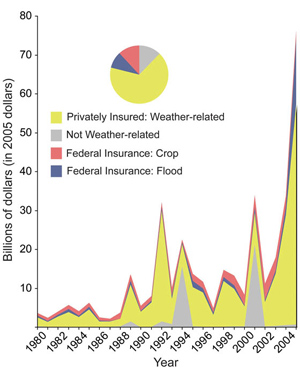 View enlarged image
View enlarged image
Weather-related and non-weather-related insurance losses over time. Smaller-scale losses (many of which are weather-related) are not shown since they are not comprehensively reported by the U.S. insurance industry. Source: USGCRP (2009)
Impacts on Economic Activities and Services
Certain areas of the United States benefit from being located close to natural resources that support the local economy. Climate change could threaten these resources, as well as the goods and services they produce and the jobs and livelihoods of those who depend upon them. [1] For example, climate change will likely affect farming communities, tourism and recreation, and the insurance industry.
- Communities that developed around the production of different agricultural crops, such as corn, wheat, or cotton, depend on the climate to support their way of life. Climate change will likely cause the ideal climate for these crops to shift northward. Combined with decreasing rural populations, as in the Great Plains, a changing climate may fundamentally change many of these communities. Certain agricultural products, such as maple syrup and cranberries in the Northeast, may disappear entirely from the United States. These crops would then have to be imported. [1]
- Climate change will also likely affect tourism and recreational activities. A warming climate and changes in precipitation patterns will likely decrease the number of days when recreational snow activities such as skiing and snowmobiling can take place. In the Southwest and Mountain West, an increasing number of wildfires could affect hiking and recreation in parks. Beaches could suffer erosion due to sea level rise and storm surge. Changes in the migration patterns of fish and animals would affect fishing and hunting. Communities that support themselves through these recreational activities would feel economic impacts as tourism patterns begin to change. [1]
- Climate change may make it harder and more expensive for many people to insure their homes, businesses, or other valuable assets in risk-prone areas. Insurance is one of the primary mechanisms used to protect people against weather-related disasters. [1] We rely on insurance to protect investments in real estate, agriculture, transportation, and utility infrastructure by distributing costs across society. Climate change is projected to increase the frequency and intensity of extreme weather events, such as heat waves, droughts, and floods. These changes are likely to increase losses to property and cause costly disruptions to society. Escalating losses have already affected the availability and affordability of insurance. More frequent losses, increased variability in the type and location of impacts, and increases in widespread losses that occur at the same time would increase the risks to insurers and their customers. [1]
To learn more about how society can adapt to climate change impacts, please visit the adaptation section of the Society Impacts & Adaptation page.
References
1. USGCRP (2009). Global Climate Change Impacts in the United States . Thomas R. Karl, Jerry M. Melillo, and Thomas C. Peterson (eds.). United States Global Change Research Program. Cambridge University Press, New York, NY, USA.
2. CCSP (2008). Analyses of the effects of global change on human health and welfare and human systems . A Report by the U.S. Climate Change Science Program and the Subcommittee on Global Change Research. [Gamble, J.L. (ed.), K.L. Ebi, F.G. Sussman, T.J. Wilbanks, (Authors)]. U.S. Environmental Protection Agency, Washington, DC, USA.

